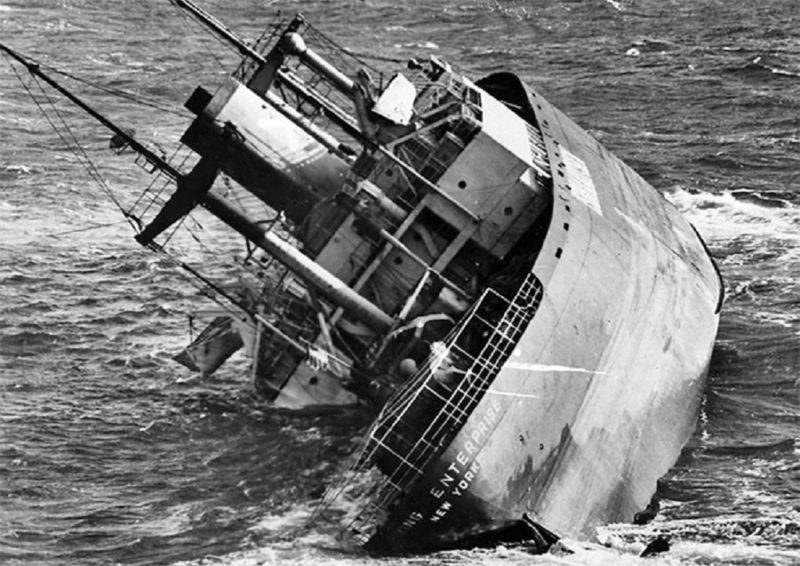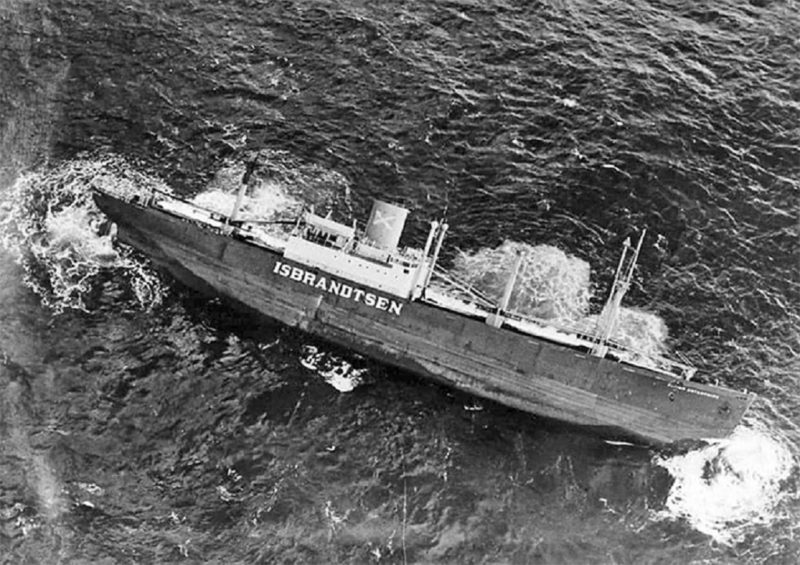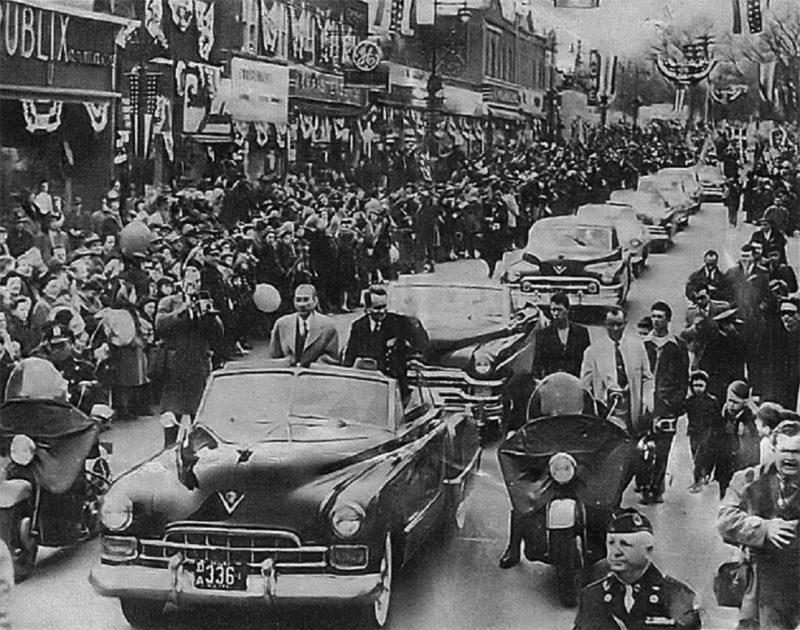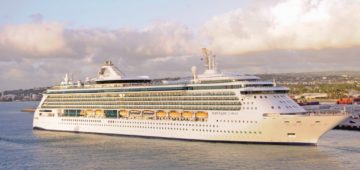A true account of a ship’s Master staying with his ship until the very last moment
SS Flying Enterprise was a 6,711grt Type C1-B ship which sank in 1952. She was built in 1944 as SS Cape Kumukaki for the United States Maritime Commission for service in World War II. At the conclusion of hostilities, the ship was sold in 1947, and then operated in scheduled service under its new name Flying Enterprise, by Isbrandtsen Lines, mainly on the North Atlantic service. Isbrandtsen Lines, New York, was the leading US-flag shipping company from 1919 to 1977 operating between the U.S. east coast and the Mediterranean, offering both freighter and passenger ship services, until it became insolvent and declared bankrupt, when it was acquired by Farrell Lines of New York, in 1977.
On 21st December 1951, under the command of Henrik Kurt Carlsen, she left Hamburg, Germany bound for the USA. Among her cargo was 1,290 tons of pig iron and 494 tons of coffee, 454 tons of rags, 39 40 tons of peat moss, twelve Volkswagen cars, antiques and antique musical instruments, typewriters, 454 tons of naphthalene as well as ten passengers.
Four days later, on Christmas night, she encountered a storm in the Western Approaches to the English Channel. The stow of pig iron in the cargo holds shifted and collapsed causing the ship to list heavily to port. At some point the motor vehicles also broke loose causing the ship to increase its list even more. The ship’s hull and deck plating cracked just aft of the superstructure. This was a known problem with ships of this design during this era, hence the crew could do little and attempted to continue their voyage. The lifeboats on the Flying Enterprise were either lost or inoperable, due to the heavy list and rough seas.
The next morning, the ship started to list seriously, and the decision was made by the Master to abandon ship. The British flagged vessel Sherborne of John Carter (Poole) Ltd. and USS General A. W. Greely responded, Sherborne being first to arrive, early in the morning of 29th December. Carlsen, however, was reluctant to evacuate passengers and crew to a British ship. Sherborne was asked to remain on station in case the situation deteriorated before an American ship arrived. The situation did deteriorate, just as USS General A W Greely arrived mid-afternoon and both ships sent lifeboats to pick up passengers and crew. The crew and passengers were evacuated with the loss of one life (a male passenger). Captain Carlsen remained onboard. The procedure was to send a lifeboat close but not so close that it would be smashed against the listing ship. For the first rescue the crew of the lifeboat threw a rope to the ship, but later jumpers had to jump in pairs and swim to the lifeboat without a rope. Sometimes passengers were swept back onto the Flying Enterprise.
On 3rd January the salvage tug Turmoil arrived. However, the ship’s Master, Captain Henrik Kurt Carlsen, chose to remain onboard, along with the Chief Mate of the Turmoil, Kenneth Dancy.
Captain Carlsen refused to abandon ship until it either sank or was towed to a safe harbour. Towing efforts were attempted and were successful in towing the ship until it was only 40 miles from Falmouth. At that point in time, the tow line parted.
Attempts were made to reconnect the tow and continue, but the ship listed more heavily, and Captain Carlsen finally abandoned ship along with Mr. Dancy, choosing to leave via the funnel as the ship listed further. The salvage attempts were criticized as the ship might have been saved by heading for the nearest safe harbour of Cork, rather than attempting to maintain the tow all the way to Falmouth. She sank on 10th January 1952.

Immediately after the sinking, there was much speculation into why the ship sank as well as to why the Master remained onboard. The most common theory is that the Pig Iron in the forward holds had been poorly stowed and therefore shifted to the side during the heavy rolling and pounding of the ship in the seaway and swells. The shifting of such heavy cargo would account for the 60-degree list to port.
Captain Carlsen may have remained onboard in order to protect the cargo and owners’ interests. Onboard was a shipment of $600,000 being sent from Europe to America. There was another shipment of cash totaling over $200,000 in the mail room. Under International Salvage Laws, if the captain had abandoned the ship with no intention of return, then any salvage company could have made claim under the “Laws of Salvage”. By remaining onboard, Captain Carlsen prevented that from occurring.
In 1960, some $210,000 of the $800,000-worth of cargo was salvaged from Flying Enterprise by the Italian company Sorima. Under a confidentiality clause in the salvage contract, further details of the recovered cargo were not released.
Most investigations suggest it was a consortium of Swiss Bankers who financed the salvage operations. There was also considerable speculation about a shipment of Zirconium, intended for use in the first nuclear submarine USS Nautilus, but declared as Pig Iron on the ship’s cargo manifests. The truth will likely never be revealed.
Captain Carlsen was awarded a Lloyd’s Silver Medal for Meritorious Service in recognition of his efforts to save his ship.
He received a ticker-tape parade in New York City on 17th January 1952. He died on 7th October 1989 age 75. He was buried at sea at the Flying Enterprise’s final resting place on 8th February 1990.
Kenneth Dancy was awarded the Order of Industrial Heroism medal by the Daily Herald newspaper and an illuminated citation from the American Institute of Marine Underwriters. He died on 3rd August 2013, aged 88.
In addition the ships owners made payments in respect of the bravery of the Turmoil’s crew – £750 to Captain Parker, £500 to Dancy and £1,250 to be distributed among the 26 crew, the gifts presented by the US Ambassador Walter Sherman Gifford.








Comments
Sorry, comments are closed for this item